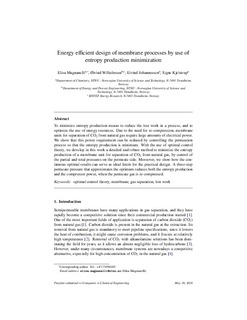| dc.contributor.author | Magnanelli, Elisa | |
| dc.contributor.author | Wilhelmsen, Øivind | |
| dc.contributor.author | Johannessen, Eivind | |
| dc.contributor.author | Kjelstrup, Signe | |
| dc.date.accessioned | 2018-08-28T13:31:25Z | |
| dc.date.available | 2018-08-28T13:31:25Z | |
| dc.date.created | 2018-06-06T12:26:17Z | |
| dc.date.issued | 2018 | |
| dc.identifier.issn | 0098-1354 | |
| dc.identifier.uri | http://hdl.handle.net/11250/2559699 | |
| dc.description.abstract | To minimize entropy production means to reduce the lost work in a process, and to optimize the use of energy resources. Due to the need for re-compression, membrane units for separation of CO2 from natural gas require large amounts of electrical power. We show that this power requirement can be reduced by controlling the permeation process so that the entropy production is minimum. With the use of optimal control theory, we develop in this work a detailed and robust method to minimize the entropy production of a membrane unit for separation of CO2 from natural gas, by control of the partial and total pressures on the permeate side. Moreover, we show how the continuous optimal results can serve as ideal limits for the practical design. A three-step permeate pressure that approximates the optimum reduces both the entropy production and the compressor power, when the permeate gas is re-compressed. | nb_NO |
| dc.language.iso | eng | nb_NO |
| dc.publisher | Elsevier | nb_NO |
| dc.rights | Attribution-NonCommercial-NoDerivatives 4.0 Internasjonal | * |
| dc.rights.uri | http://creativecommons.org/licenses/by-nc-nd/4.0/deed.no | * |
| dc.title | Energy efficient design of membrane processes by use of entropy production minimization | nb_NO |
| dc.type | Journal article | nb_NO |
| dc.type | Peer reviewed | nb_NO |
| dc.description.version | acceptedVersion | nb_NO |
| dc.source.pagenumber | 105-116 | nb_NO |
| dc.source.volume | 117 | nb_NO |
| dc.source.journal | Computers and Chemical Engineering | nb_NO |
| dc.identifier.doi | 10.1016/j.compchemeng.2018.06.002 | |
| dc.identifier.cristin | 1589411 | |
| dc.description.localcode | © 2018. This is the authors’ accepted and refereed manuscript to the article. Locked until 15.6.2020 due to copyright restrictions. This manuscript version is made available under the CC-BY-NC-ND 4.0 license http://creativecommons.org/licenses/by-nc-nd/4.0/ | nb_NO |
| cristin.unitcode | 194,66,25,0 | |
| cristin.unitcode | 194,64,25,0 | |
| cristin.unitname | Institutt for kjemi | |
| cristin.unitname | Institutt for energi- og prosessteknikk | |
| cristin.ispublished | false | |
| cristin.fulltext | postprint | |
| cristin.qualitycode | 2 | |

